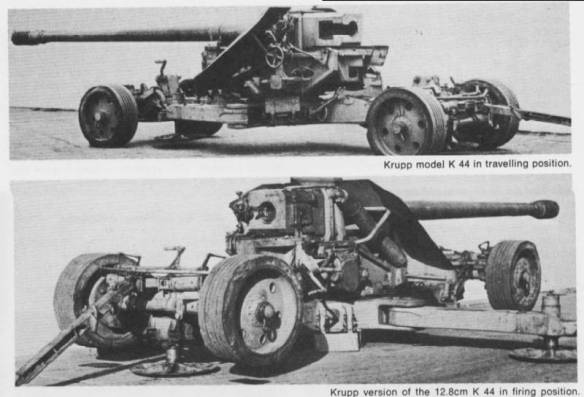There were two versions of the 12.8 cm K 44 tested by the Germans during the Second World War, differing only on the type of carriage used.
Version one: The Krupp model had a cruciform platform with outriggers, carried on two two-wheel axles that could be swung from the ground as the platform was lowered by a simple hand-operated arc and pinion mechanism. The top carriage revolved on four rollers running around a racer plate on the lower carriage and was centred o by a simple pivot.
Version two: The Rheinemetall-Borsig model also used a carriage of the cruciform type, carried on a two-wheel bogie at the front and a four-wheel bogie at the rear. The front bogie was removed completely on coming into action, while the rear bogie was raised from the ground but remained on the carriage to form part of the traversing mass and to add to the gun’s stability.
It was generally agreed that the Krupp design was the cleaner and better of the two, though critical examination showed that certain parts of the carriage – especially the wheel-raising gear and the traversing arrangements – were somewhat underweight for their tasks and might not have lasted long in service.
Although prototypes were made, no complete weapons entered service though a number of gun barrels (51 according to some reports) were made and fitted to extemporised carriages.
These being as follows:
12.8 cm Kanone 81/1: This was the K 44 ordnance mounted on the ex-French 155 mm Mle GPF-T carriage.
12.8 cm Kanone 81/2: This was the K 44 ordnance mounted on the ex-Russian 152 mm Model 1937 howitzer carriage.
The 12.8cm Pak 44/ K44 was designed as a dual purpose anti tank and field gun. Prototypes only were built. However the barrel was produced. A version, the K81, was intended for use in AFV. 50 barrels were converted and fitted to a carriage from the French Canon de 155 GPF-T. These were issued as 12.8cm Kanone 81/1.
A small number of barrels were fitted to the Soviet 152mm Gun howitzer carriage obr,. 1937 and used as the 12.8cm Kanone 81/2.
Both of these were intended to be field and anti tank guns.
page 120 Small Arms Artillery and Special Weapons of the Third Reich Gander and Chamberlain ISBN 0 354 01108 1 has a pic of US troops and a captured 12.8cm Kanone 81/1
The 12.8cm weapons weighed in at well over twice the weight of the 8.8cm Pak and were beyond the ability of crews to shift far without the aid of vehicles. This and their massive bulk limited their effectiveness as a wheeled anti tank gun although its ability to penetrate armour is beyond question eg 148mm at 30 degrees from vertical at 2000 m with Pzgr43.
Usage of the Pak 44 in combat
There is somewhat good account of the deployment of the Pak 44 in Andrew Devey’s “Jagdtiger” Vol.1 pages 33-6.
The field guns were designated 12,8cm Kan 81/1,(using the French 155 mount) or the 12,8cm Kan 81/2 (using the Russian 152 mount).
On Oct.25.44, a “Fuhrerbefehl” ordered that 52- 12,8cm Pak 80 (up until Sept ’44 known as the Pak 44) be diverted from the Jagdtiger program and mounted on Russian and French carriages.
On Nov.8.44, the Gen.Insp.d.Artillerie ordered the deployment of the 12,8cm Kan with the organization of 4 Batterien under K.St.N 479a v. 1.10.43 each with 10 12,8 Kan, (7- Kan 81/2, and 3- Kan 81/1 each).
The following Batterien were created:
Batterie 1092
Batterie 1097
Batterie 1124
Batterie 1125
All were sent to the Western Front in anticipation of the Ardennes Offensive and were in the assembly position by Nov.22.44.
As for their exact assignment you’ll have to consult Pallud’s “Battle of the Bulge-Then and Now”, or Parker’s “Hitler’s Last Gamble” I don’t know how the units were employed, as Pak or as Artillerie, but the order dated Nov.8 show a very low number of Pz.G.R. rounds
